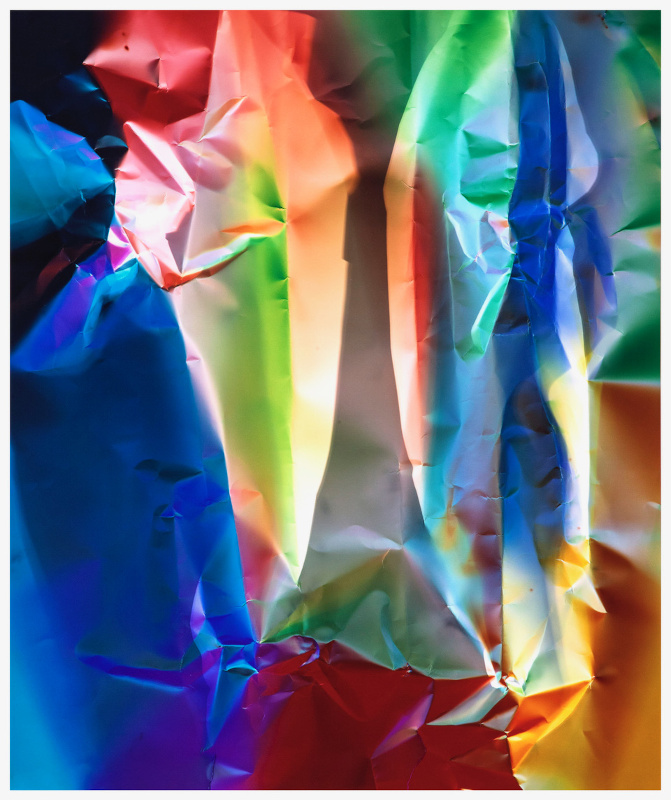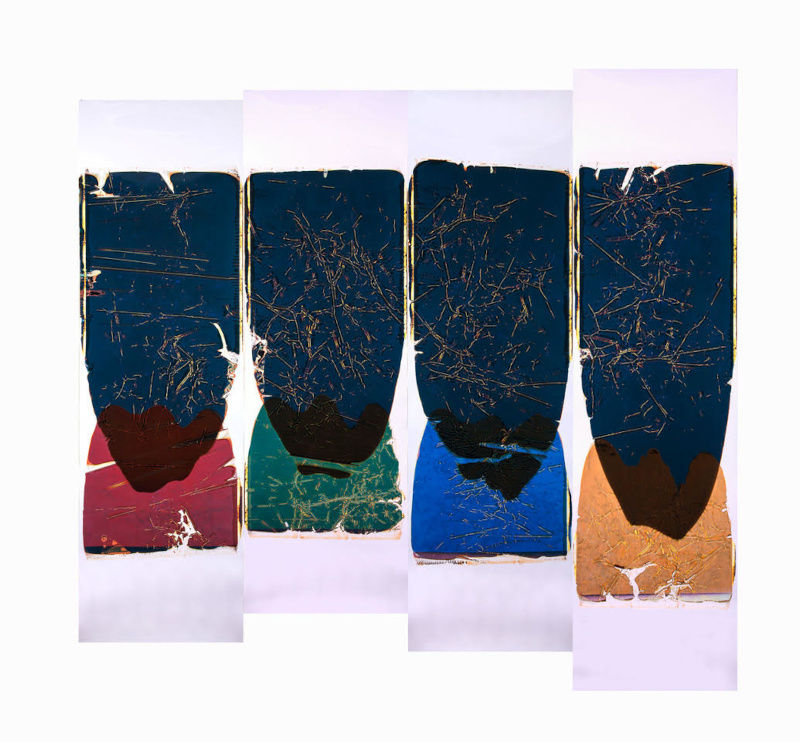
RGBY Photographic Colour Theory, Pictures, Poems and Birds Who Sing
by Ellen Carey and Donna Fleischer
- View Ellen Carey's Biography
Ellen Carey an experimental lens-based artist and is one of the top 100 international women photographers as named by The Royal Photographic Society.
- View Donna Fleischer's Biography
Donna Fleischer is a poet, essayist, and blogger at word pond.
RGBY Photographic Colour Theory, Pictures, Poems and Birds Who Sing
ELLEN CAREY and DONNA FLEISCHER

Image credit: Dings and Shadows, Ellen Carey, Color Photogram, C-Print, Unique, 2018, 24"H x 20"W. Private Collection. CT, USA.
Imagine a blue jay or a mourning dove calling through the air, while ruffling, and smoothing feathers into song and wings. Ellen Carey's force majeure use of photographic colour theory and materials invents new colours, textures, and shapes that are her lens-based, minimal, abstract pictures and Donna Fleischer's synaesthesia poetics translates Carey's pictures into poems. These bird and non-bird interactions horizon new enactments of community.
Speculation and Sequential Temporalities Between Birds and Non-Birds
Imagine that the white, blank, and silent spaces of photographic and unruled, writing paper take on permutated rubbings of bone white sky with grey-laced clouds fronting all other skies — / the sky / of many skies, / remember? //.1 It might be an ancient, oral sky speaking through rain, snow, thunder, lightning, infinitely layered colours, whites and blacks wherein weather, bird, non-bird and sky are one. Ascent through onomatopoeia could be a mystical fourth knowing, a reaching for or revealing yet another layer, like a bird's congerie of overlapping feathers.
Ellen Carey's first Polaroid Pull was a new photographic object, that of the parabola as seen in the natural world in the shape of a wing or a comet. Her speculative approach is best described by a Venn diagram of overlapping varieties of colours in feather-blended hues that see links in a shared universe in visual codes; i.e. symmetrical and asymmetrical forms — fractals, circles, spirals — found on birds are a visual language.2
jay’s blues
night feathers dawn
stars still on
its cresting head
as if it barely brushed
the sky just at
that moment kissed
when day
meets night when
eyes open
Interspecies Sympoïesis
The blue jay who arrives with rising crest and feathers fanning as it shrieks, whistles, and chortles is reminiscent of the roadrunner foil for the 'Wily Coyote' trickster figure in American literature and comics. For the American artist, John James Audubon, as well as birders and photographers generally, this arrival is a field day for picture-making and taking. For Ellen Carey, light, shape, texture, and color are split seconds of picture-making in her abstract and minimal field where the object percolates through controlled light, photographic colour theory, and chemical emulsion to the surface where it speaks for itself. Donna Fleischer's poetry hears and sees the blue jay and the mourning dove in Carey's equal and companionable light-based art of being, a being beyond semantics.
These pictures and poems commune via the philosopher Donna Haraway's concept of sympoïesis from her 2016 book Staying with the Trouble: Making Kin in the Chuthuculene. Sympoïesis or making with and becoming with describes the Carey-bird-language-Fleischer connection, and supplants the notion of the artist creating all by their self, God-like. Carey's light object speaks. Fleischer's poem listens. These are kin interrelations among artists and birds.
When Mourning Comes
The dove
fans softly down
to ground
blends in, picks at
i n v i s i b l e
flies back up and up and
vowels come
diphthong slowly
m o u r n
m o a n
puff-throated consonants
twinned staccato release &
the g l i d e again &
a hundred times again a
tableau twilight,
a November sun
a chalice of moon
an offering up of
w h o w h o w h o’s
a lit-up song aerial wired
a kind hello
like the Sumburgh foghorn
dream coming truer through
tissue membrane osmotic semiotic
blue-tipped bluer belled ring brown wings span
an elusive wall within our in-
between paradisal-wingèd hands
land-on-land palms down-turning-
up for
a drop of rain or snow or
salt-tear downstream
What is it we sense
in the winter walled sky
granitic
we peck or call our turtle dove
as eyelids flutter
as Thanatos beckons as Eros who climbs

Image credit: Crush and Pull with Rollbacks, Ellen Carey, Polaroid 20 X 24 Color Prints - 2021.
Semantics of Bird Song and Parallels with Human
The bird flies and it sings! A simultaneity of pictures, songs, poem-chants, myriad shapes of colours, and flight may exist furthest back in the ancestral brain through the pulsating, rhythmic limbic system beyond language, philosophies or theories on experience. Lorine Niedecker (1903-1970), the American Objectivist poet wrote: I was the solitary plover / a pencil / for a wing bone /;3 André Breton, the French Surrealist artist and writer, proposed that imaginings tend to become real; and Wallace Stevens's poetic oeuvre and prose book, "The Necessary Angel" regards imagination as the site of primal reality. The imagination has been referred to as flights of fancy (wing-shaped); Carey's dark-winged Polaroid film negatives that she exhibits next to their Pull positives, bring to mind the following lines from American poet Theodore Roethke's poem, "Night Crow": / Over the gulfs of dream / Flew a tremendous bird / Further and further away / Into a moonless black, / Deep in the brain, far back. //
The dictionary or denotative meaning for a word might be enough as we light up unconscious linguistic rules of syntax stringing words together for endless combinations of sentences. Yet, native speakers continuously adapt what they say to the context in which they are speaking, making contextual or connotative meaning based on personal associations and memories. Our unconscious backlights these associations as we non-birds interactively make and interpret meaning. Ellen Carey and Donna Fleischer, as visual and literary artists, respectively, bring semantics into existence on a level similar to how we use language as native speakers. For us non-birds everything has meaning — everything is a sign indicating meaning. Through Ellen Carey's art-making, indexical use of light with time, photographic color theory, substrates treated with light-sensitive chemicals, and technology a new object exists. It speaks in shape, scale, size, texture and color. Fleischer see-hears these artworks through poïesis. Photography and poetry engage in a conversation of spirit, intellect, physical senses, emotion, memory, imagination and intuition. The 2021 poems, "jay's blues" and "When Mourning Comes" continue this conversation.
When we non-birds see colour our beings seem to fly and our consciousness is elevated. We become one with birds and non-birds. The modern French poet Rimbaud's poetry shoulders synaesthesia — the capacity for seeing color in sound, sound in color. For more than a decade Donna Fleischer has been looking into Carey's photograms and Polaroid Pulls through her synaesthesia poetics. She wrote The Black Swans of Ellen Carey: Of Necessary Poetic Realities, the catalogue essay for Carey's solo exhibit, "Let There Be Light: The Black Swans of Ellen Carey," and included her haibun poem of ekphrasis on Ellen Carey's photogram of the same name, "The Red Photogram."
Does anyone really care that in the Greek myth of Icarus he fell into the sea? Breughel's painting, "Landscape with the Fall of Icarus" (1560) foregrounds a farmer among other peers going about their daily commerce, while off in the distant background a viewer may notice the tiny pleat in the ocean marking the splash point of his entry and death. Sure, he flew too close to the sun but he flew! became Bird being, spirit being at the end.
When viewing Carey's 'black swans', Fleischer experiences presence and a marked absence of presence. We are not alone in this universe.

